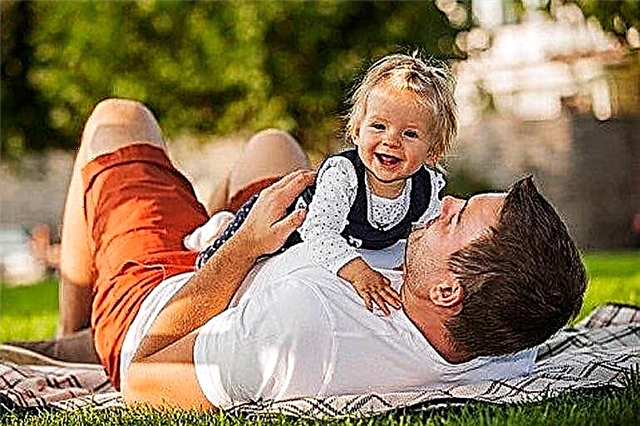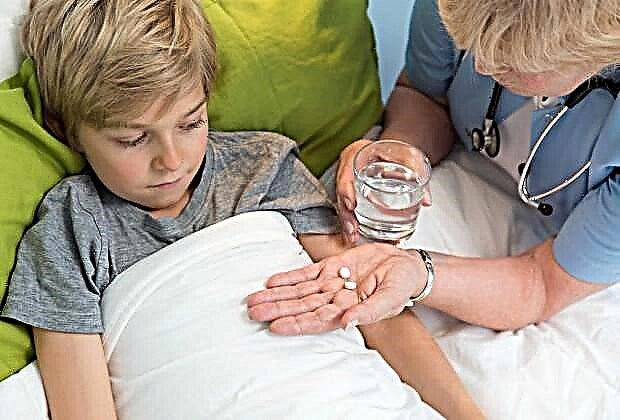One of the constant questions for progressive young mothers is the topic of swimming with babies in the pool. Although the benefits of learning to swim are undeniable, and pediatricians generally recommend children to swim, discussions on this topic continue.

Baby swimming in the pool is useful and enjoyable
Congenital swimming instincts
After birth and up to 3 months of age, a child retains a number of skills innate at the instinctive level, which are due to being in the liquid environment of the mother's abdomen for a long time. Among them, the most important one, which helps all the crumbs to stay on the water, is the swimming reflex.

Swimming instinct of newborns
Also, children have a developed respiratory reflex - they are able to hold their breath when immersed under water with their heads. It is he who makes it possible to teach such kids to dive without problems, while older children can simply sip on water and get scared for a long time.
Another ready-made swimming reflex is a jerk one: when the legs are forcibly bent, the newborn immediately unbends them, which allows, over time, to push off from the bottom and sides of the pool.
In addition, the baby's body contains more lecithin fats, so its specific gravity is much less than that of an adult, which has a positive effect on buoyancy and the ability to easily float on the surface of the water.
Maintaining these unconditioned reflexes, given by nature for survival in extreme situations, allows babies to learn to swim perfectly at a very early age, although the limbs are not yet fully under their control.
The benefits of swimming for babies
The positive effects of swimming in the pool for newborns are quite numerous, therefore pediatricians often recommend it to strengthen the immune properties of the baby's body, normalize muscle tone and develop skeletal structure as exercise therapy.
Pros and cons of early swimming
Swimming for babies is comparable in effectiveness to innovative physiotherapy or manual therapy sessions. The water in the pool or bath produces a physiological massage of the baby's muscles, has a positive effect on the baby's skin and activates the blood supply and metabolic processes. Regular visits to the pool with mothers help to improve the sleep and appetite of babies, reduce and stop intestinal colic.
It has also been known since ancient Greece that swimming skills increase the level of intellectual development of children. A kid who has been in the pool since birth grows up more inquisitive and active than his peers, and is less likely to get sick.
Constant feasible physical activity in water strengthens the cardiovascular (even the level of hemoglobin in the blood rises), nervous, respiratory and musculoskeletal systems of the child, and forms the correct posture.
Additional Information. Classes with parents help improve psycho-emotional contact, form a positive perception of the world.
Like any developmental methodology, classes in a pool with a baby have their opponents, who think about the negative impact of the aquatic environment of an artificial reservoir on a child. They believe that it is not necessary to expose the fragile organism of a little man to unsanitary conditions and a large number of bacteria in public swimming pools, that it is worth waiting for the child to grow up and adapt to life outside the womb.
Another argument against early swimming is called the possible stressful reactions of the baby to the aquatic environment, which is fraught with the emergence of a constant feeling of fear and insecurity.
Swimming indications
Classes in the infant pool are often prescribed as one of the types of physical activity and exercise therapy to strengthen the immunity of often ill, but generally healthy children. Swimming for sick babies is prescribed for the following reasons:
- hypertonicity - smooth movements in the water perfectly relax tense muscles;
- decreased muscle tone - cooler water and vigorous movements (including diving) activate the muscular system;
- high nervous excitability - the nervous system also comes to order due to improved sleep quality;
- medium and low degree of prematurity - for low birth weight children this is the best way to get stronger and develop on a par with their peers;
- dysplasia of the hip joints - the child learns to move independently, and the joints and ligaments are gently trained;
- valgus foot, flat feet - swimming strengthens the calf muscles, avoids flat feet and other foot deformities;
- torticollis - adjusting staleness is corrected, pinched neck muscles relax;
- cerebral palsy - water rehabilitation significantly improves the motor activity of such children, corrects complications.

Swimming is shown to babies with cerebral palsy
Contraindications
Unfortunately, for some babies, a baby pool is contraindicated. You can not go swimming with the following pathologies:
- congenital malformations of the cardiovascular system;
- infectious diseases in the acute period;
- disorders of the neurological system in the presence of periodic seizures;
- pathologies in the musculoskeletal system, in which the limbs must be fixed;
- if the baby has a strong fear of water.

If the baby is afraid of water, do not make him swim.
Swimming rules with babies in the pool
Teaching the baby to swim is carried out in compliance with certain rules and regulations that must be strictly observed in order to achieve a positive effect from classes in the pool.
At what age to start
Most pediatricians agree that classes should be started only when the umbilical wound in the baby has healed to avoid infections. In addition, the baby must be given time to get used to and adapt to the conditions of existence outside the mother's womb. The optimal time is the age of 2-3 months.
Important! It is necessary to start before the crumbs lose their innate swimming instincts, and you will have to develop these skills from scratch, overcoming the child's fear of water.
If you do not have time before the age of 3 months, this is not scary, the child will still get healthier, and you can learn to swim and dive later.
Safety engineering
An open, filled pool is a source of danger for helpless toddlers. Therefore, parents and coaches who work with them should strictly adhere to the safety rules:
- children can attend classes only with medical certificates from a pediatrician (for parents - from a dermatologist);
- to avoid water contamination with urine and feces, babies under 3 years old should be in special swimming diapers;
- the child should constantly be close to the adult, be in his field of vision;
- run in the pool area, incl. on the sides is strictly prohibited;
- parents need slippers with anti-slip soles;
- if it is necessary to leave classes before their end, it is necessary to inform the coach about this;
- it is highly not recommended to go down to the pool on your own with a baby - it is better to use the help of an instructor;
- going up and down the stairs must always face the side.
Recommendations
In order to start visiting the pool for newborns, no special preparation is required, except that gradually accustom the baby to the water temperature. It is recommended to start at 36-37 degrees, gradually reducing the heat. In addition, you should not break the children's sleep schedule - it is best to schedule classes for 3-4 pm, after a day's rest. The duration of water procedures should not exceed a quarter of an hour, for older children - up to 25-30 minutes. If the child shows signs of fatigue, the activity should be stopped.
Interesting. Children can swim every day, for them and their parents, swimming should be a fun game that brings pleasure and health.
It is recommended to start with a bath filled with plain clean water at a temperature of 36 degrees; after the procedure, the navel is treated as usual. Mom should be calm, her hands firmly and securely hold the young swimmer. In the process of getting used to the water, it is imperative to communicate with the baby, to encourage him to move.
Pool activities for mom and baby
Swimming in the pool for infants is taught with the participation of parents, usually mothers. Quite often, classes (especially as prescribed by a pediatrician) are held in special children's pools at polyclinics: they are small in size (5 by 8 meters) and depth, the water in them is always warm and pleasant for children. Sometimes similar or slightly large pools are available in kindergartens, they can be attended by kids even from nursery groups. Swimming courses for babies are also offered at fitness clubs and regular municipal pools.
What you need for classes
The main condition is the availability of a standard health certificate for the pool: for the mother and the little swimmer (from a therapist, pediatrician, dermatologist-venereologist, gynecologist).
You should prepare in advance everything you need to swim in the pool for babies:
- swimming caps (for babies - with foam or inflatable elements);

Bathing cap for babies
- swimsuit for mom and swimming trunks for the child;
- removable shoes (slippers with non-slip soles);
- a hairdryer for blowing out the baby's ears after the session;
- baby moisturizing milk to lubricate the delicate skin of the baby;
- a large "furry" towel to wrap up the baby after getting out of the water.
Exercises
Newborns and infants, having come to the pool, do not just flounder senselessly in pleasant water, parents, under the guidance of a coach or instructor, perform various exercises with them.
First of all, these are movements for the adaptation of the baby to the water. The child is supported vertically under the chest and butt, and the legs are gradually lowered into the water. In this case, swinging in different directions, zigzag and circular movements are performed. After the baby is used to the new environment, the support becomes horizontal.
Holding the child with one hand, horizontal postings are performed back and forth and "figure eight". Using the pushing reflex, pushing with the legs from the sides is practiced at the mother’s command “push!”. As far as the crumb is repelled, the further it should be moved away from the edge of the pool, so he understands his strength. You can also jump back and forth, pushing off the bottom of the pool (the child is held with both hands).
Note! Throughout the lesson, the child's face, especially in the early stages of learning, should not be immersed in water.
Exercise "helicopter" is performed with support under the chest with one hand, and with the free, alternately raking water with the baby's handle.
Putting the baby's head on the palm (the little finger is placed under the vault of the skull), hold the baby in this position on the surface of the water, you can hold the chin with the other hand. If everything works out, various postings are made along the pool. The fontanelle should be closed when turning. Some children like calm, unhurried movements, others squeal with delight at high-speed passage of a distance.
With support on the stomach (the mouth is covered with an adult's thumb to avoid swallowing water), the crumbs have the opportunity to work with their arms and legs from the very first lessons, they really like it. Also in this position, the cervical muscles are perfectly trained, which allows newborns to start holding their head earlier.

Belly harnesses
Council. If the child does not like one exercise, he must move on to another, which he likes more.
Between exercises, it is imperative to take breaks for rest: the baby can hang vertically on the mother's arm, throwing both arms over it, support under the chest. To prevent the child from freezing, his back can be watered. Some crumbs like to relax in a position on their side, as if reclining.
Diving is very important in the pool for babies. Children are prepared for diving by pouring water from a ladle over their heads between exercises. At the same time, mom says the command "Dive!" and blows the child in the face so that he closes his eyes and holds his breath. Then all the water is immediately poured out. If the baby doesn’t like the procedure, he must be reassured, not pulling him out of the pool, but simply shaking him in the water. The breath-holding reflex to the command usually develops after 2 weeks of preparation, ten repetitions per lesson.

Baby is diving
The first diving is carried out in a relaxed state and a good mood of the little swimmer. It is best to do this from a prone position, the child for a few seconds (after the command) plunges into the water with his head and is brought to the surface. Be sure to praise your baby after every successful dive. You need to start with 2-3 dives per lesson, then you can do them more often and keep the child under water longer (up to 5-6 seconds).
The benefits of swimming in the pool for babies are obvious, although they also have their opponents. However, pediatricians believe that early swimming training significantly strengthens the health and immunity of babies, helps with serious diseases of the musculoskeletal system and muscle tone. It is recommended to start early, until the swimming reflexes, given from birth, have died out, but not before the navel falls off. Based on the opinions of doctors, parents decide for themselves whether their child should swim, guided by his individual characteristics.



